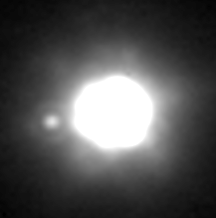 762 Pulcova and satellite as seen with adaptive optics in 2000[1] | |
| Discovery[2] | |
|---|---|
| Discovered by | G. N. Neujmin |
| Discovery date | 3 September 1913 |
| Designations | |
| (762) Pulcova | |
| Pronunciation | /ˈpʊlkəvə/ |
Named after | Pulkovo Heights |
| 1913 SQ | |
| Main belt | |
| Adjectives | Pulcovian /pʊlˈkoʊviən/[3] |
| Orbital characteristics[2] | |
| Epoch 31 July 2016 (JD 2457600.5) | |
| Uncertainty parameter 0 | |
| Observation arc | 100.08 yr (36553 d) |
| Aphelion | 3.4801 AU (520.62 Gm) (Q) |
| Perihelion | 2.8291 AU (423.23 Gm) (q) |
| 3.1546 AU (471.92 Gm) (a) | |
| Eccentricity | 0.10319 (e) |
| 5.60 yr (2046.5 d) | |
| 348.62° (M) | |
| 0° 10m 33.276s / day (n) | |
| Inclination | 13.089° (i) |
| 305.76° (Ω) | |
| 189.54° (ω) | |
| Known satellites | S/2000 (762) 1[1] |
| Earth MOID | 1.84297 AU (275.704 Gm) |
| Jupiter MOID | 1.60162 AU (239.599 Gm) |
| TJupiter | 3.158 |
| Physical characteristics | |
Mean radius | 68.54±1.6 km |
| Mass | 1.40×1018 kg[4] |
Mean density | 0.90 g/cm3[4] |
| 5.839 h (0.2433 d) | |
| 5.839 hr[2] | |
| 0.0458±0.002[2] | |
| 11.93 to 14.79[5] | |
| 8.28[2] | |
762 Pulcova is a main-belt asteroid. It was discovered by Grigoriy N. Neujmin in 1913,[2] and is named after Pulkovo Observatory, near Saint Petersburg. Pulcova is 137 km in diameter,[2] and is a C-type asteroid, which means that it is dark in colouring with a carbonate composition.
Photometric observations of this asteroid from Leura, Australia during 2006 gave a light curve with a period of 5.8403 ± 0.0005 hours and a brightness variation of 0.20 ± 0.02 in magnitude. This result is in agreement with previous studies.[6]
YouTube Encyclopedic
-
1/5Views:3277651 0088931 149
-
Some Asteroids May Even Have Moons In The Solar System #shorts
-
Rhodope occults Regulus
-
Incredible footage of Saturn rising from behind the Moon during a lunar occultation
-
Star Gazers Aug 26 - Sept 1, 2013 5 minute version
-
Grazing Occultation by Asteroid Iduna
Transcription
Satellite


On February 22, 2000,[1] astronomers at the Canada-France-Hawaii Telescope on Mauna Kea, Hawaii, discovered a 15-km moon (roughly a tenth the size of the primary)[7] orbiting Pulcova at a distance of 800 km.[8] Its orbital period is 4 days.[9] The satellite is about 4 magnitudes fainter than the primary.[8] It was one of the first asteroid moons to be identified.
Density
In the year 2000, Merline estimated Pulcova to have a density of 1.8 g/cm3, which would make it more dense than the trinary asteroid 45 Eugenia, and binary 90 Antiope.[8] But estimates by Marchis in 2008 suggest a density of only 0.90 g/cm3,[4] suggesting it may be a loosely packed rubble pile, not a monolithic object.
References
- ^ a b c "762 Pulcova". SwRI. 22 February 2000. Retrieved 20 October 2009. (AO image)
- ^ a b c d e f g "JPL Small-Body Database Browser: 762 Pulcova (1913 SQ)" (2009-09-22 last obs). Retrieved 5 May 2016.
- ^ Catalogue of the Mathematical, Historical, Bibliographical and Miscellaneous Portion of the Celebrated Library of M. Guglielmo Libri, 1861, p. 216
- ^ a b c Jim Baer (2008). "Recent Asteroid Mass Determinations". Personal Website. Archived from the original on 2 July 2013. Retrieved 28 November 2008.
- ^ Magnitudes generated with JPL Horizons for the year 1950 through 2100
- ^ Oey, Julian (December 2006), "Lightcurves analysis of 10 asteroids from Leura Observatory", The Minor Planet Bulletin, 33 (4): 96–99, Bibcode:2006MPBu...33...96O.
- ^ Dr. William J. Merline & Maria Martinez (26 October 2000). "Astronomers Image Double Asteroid". SwRI Press Release. Retrieved 20 October 2009. (mentions both 90 Antiope and 762 Pulcova)
- ^ a b c W.J. Merline (SwRI); L.M. Close (ESO, U. Arizona); C. Dumas (JPL); J.C. Shelton (Mt. Wilson Obs.); F. Menard (CFHT); C.R. Chapman; et al. (21 June 2000). "Discovery of Companions to Asteroids 762 Pulcova and 90 Antiope by Direct Imaging" (PDF). SwRI. Retrieved 21 October 2009.
- ^ Johnston, Robert (1 September 2005). "(762) Pulcova". Johnston's Archive. Retrieved 1 November 2013.
External links
- Asteroids with Satellites, Robert Johnston, johnstonsarchive.net
- 762 Pulcova at AstDyS-2, Asteroids—Dynamic Site
- 762 Pulcova at the JPL Small-Body Database
